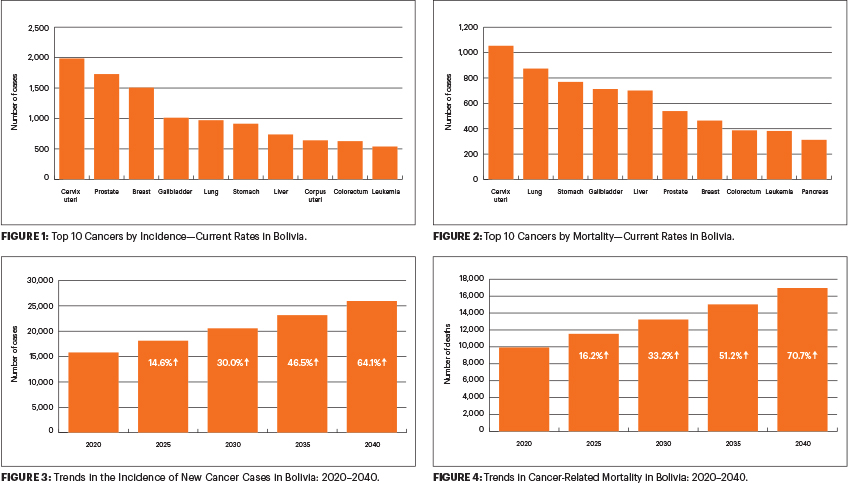The ASCO Post is pleased to continue this occasional special focus on the worldwide cancer burden. In this issue, we feature a close look at the cancer incidence and mortality rates in Bolivia. The aim of this special feature is to highlight the global cancer burden for various countries of the world. For the convenience of the reader, each installment will focus on one country from one of the six regions of the world as defined by the World Health Organization (ie, Africa, the Americas, Southeast Asia, Europe, Eastern Mediterranean, and Western Pacific). Each section will focus on the general aspects of the country followed by the current and predicted rates of incidence and cancer-related mortality. It is hoped that through these issues, we can increase awareness and shift public policy and funds toward proactively addressing this lethal disease on the global stage.

Hope Craig, MSPH

Chandrakanth Are, MBBS, MBA, FSSO, FRCS, FACS
Bolivia is a landlocked, middle-income country in central South America, neighbored by Argentina, Brazil, Chile, Paraguay, and Peru. About one-third of the country lays in the Andes Mountains, where most of the nation’s largest cities are located.1 The mountainous western region of Bolivia is an important economic and political center, as the highlands have attracted large amounts of mining, commercial, and business investments for centuries.
Over the past decade, Bolivia has made significant advancements socially and economically, with major reductions in extreme poverty, improvements in nutrition, and declines in inequality.2 Between 2005 and 2015, extreme poverty in Bolivia fell by more than half, from 38% to 17%. However, the nation remains among the lowest resourced countries in South America. About 40% of women continue to live in poverty, and indicators of gender-based violence are high.2
Health Care
Despite an increase in recent years, budgetary resources allocated for health care in Bolivia remain low. In 2019, health care accounted for 6.9% of Bolivia’s gross domestic product. Although this represents an increase from 4.6% in 2014, it is still below the Organisation for Economic Cooperation and Development average of 7.7%.3,4

While free health care is offered to children younger than age 5 and adults older than age 60, whereas adults younger than 60 do not have the same provisions. As a result, out-of-pocket health-care spending is high (23.1%), according to WHO 2014 estimates.4 This is far above the regional average of 13.7% in the Americas and the global average out-of-pocket spending on health care of 18.2%.
Cancer Profile
Cancer remains a serious public health concern in Bolivia. Cervical cancer has the highest incidence, with almost 2,000 new cases reported in 2020, according to WHO data (Figure 1).5 The next highest cancers by incidence in Bolivia are prostate cancer (1,729 cases), breast cancer (1,508 cases), gallbladder cancer (1,012 cases), and lung cancer (971 cases).
Cervical cancer is also responsible for the largest number of cancer-related deaths, with 1,054 deaths reported in 2020 (Figure 2). The next highest causes of cancer-related deaths in Bolivia in 2020 were lung cancer (874 deaths), stomach cancer (769 deaths), gallbladder cancer (713 deaths), and liver cancer (701 deaths).
At this rate, without concerted efforts, the number of cancer cases in Bolivia is expected to rise more than 64% by 2040 (from 15,817 cases in 2020 to an estimated 25,950 cases in 2040; Figure 3). Similarly, cancer-related mortality is expected to increase more than 70% during the same period, from 9,935 cancer-related deaths in 2020 to over 16,950 deaths in 2040 (Figure 4).
Cancer Care Initiatives
Cervical cancer remains a particularly prominent challenge in Bolivia, representing about one in four cancers among women and accounting for about 30% of all new cancer cases.4 Furthermore, in 2018, Bolivia had the highest estimated incidence rate of cervical cancer (38.5%) in all of Latin America and the Caribbean.6 To address this problem, the Bolivian government is taking steps to improve cervical cancer immunization and screening rates. The human papillomavirus vaccine, for example, is now free for girls aged 10 to 12. Preventive programs such as this, however, tend to be difficult to reach for much of the population. According to Soneji et al, less than 55% of eligible women in Bolivia receive appropriate Pap smear screenings.7 Though the services are free, cancer care systems are not in place to streamline testing, detection, diagnosis, and treatment.
The Latin America Cancer Control Scorecard (LACCS) is a rating system developed by The Economist Intelligence Unit that assesses policies and programs designed to reduce cancer care inequality in 12 countries in the region.4 The LACCS evaluates six domains of care: cancer plan, monitoring performance, medicine availability, radiotherapy availability, prevention and early detection, and finance. In most domains, Bolivia ranks low compared to other countries in the region; however, the cancer challenge that Bolivia faces is relatively moderate.

Bolivia, for example, has among the lowest overall rates of cancer incidence and mortality in the region. Nevertheless, although the country’s breast cancer plan (2009–2015) mentions social and economic determinants of health, experts suggest there is little political will to deal with cancer control in Bolivia.4 The country has, however, implemented cancer prevention strategies such as smoking bans and steps to reduce tobacco use, including tobacco control initiatives to regulate advertising and trade.8 In addition, Bolivia plans to develop a nuclear technology research center as part of its nuclear program. Such efforts would enable the center to produce radioisotopes to be used for cancer diagnostics and treatment, aiming to increase the affordability of nuclear medicine.
Relative to other countries in the region, risk factors for cancer in Bolivia have been improving, although this trend has been changing for the worse in recent times. Milton Soria, MD, of the National Institute of Health Laboratories, has drawn attention to the need for upstream intervention to address behavioral risk factors for cancer: “We are now starting to eat more junk food…. Our customs are changing, so we need a lot of enforcement, education, and communication,” remarked Dr. Soria in a brief on cancer control in Bolivia for The Economist.4
Cancer control strategies in Bolivia are divided between health services focused on noncommunicable diseases and women’s health programs. Further, nuclear medicine initiatives fall within the responsibility of the Ministry of Energy rather than the Ministry of Health. A more comprehensive cancer care approach may reduce fragmentation and streamline cancer policy management.

Milton Soria, MD
Lastly, improvements in cancer data collection and management in Bolivia would strengthen monitoring and response. There is currently no national cancer registry in Bolivia. Rather, data on incidence and other indicators are based on predictive models from neighboring countries such as Peru and Brazil. Efforts to streamline cancer control strategies and improve data monitoring may offer opportunities to develop a comprehensive cancer care approach in Bolivia.
Ms. Craig is Senior Research Analyst at Population Media Center, South Burlington, Vermont. Dr. Are is the Jerald L & Carolynn J. Varner Professor of Surgical Oncology & Global Health; Associate Dean for Graduate Medical Education; and Vice Chair of Education Department of Surgery, University of Nebraska Medical Center, Omaha.
DISCLOSURE: Ms. Craig reported no conflicts of interest. Dr. Are has a patent with the University of Nebraska Medical Center for a laparoscopy instrument.
REFERENCES
1. McFarren P: Countries of the World: Bolivia. Britannica. Available at https://www.britannica.com/place/Bolivia. Accessed August 16, 2022.
2. World Food Programme: Plurinational State of Bolivia. Available at https://www.wfp.org/countries/bolivia-plurinational-state. Accessed August 16, 2022.
3. Central Intelligence Agency: The World Factbook: Bolivia. Available at https://www.cia.gov/the-world-factbook/countries/bolivia. Accessed August 16, 2022.
4. The Economist Intelligence Unit: Cancer Control in Bolivia: Significant Room for Improvement. World Cancer Initiative, 2017. Available at https://worldcancerinitiative.economist.com/pdf/Roche-Cancer-control-access-and-inequality-in-Latin-America-A-tale-of-light-and-shadow/CancerControlinBolivia.pdf. Accessed August 16, 2022.
5. International Agency for Research on Cancer, World Health Organization: Cancer Today: Bolivia. Global Cancer Observatory, 2022. Available at https://gco.iarc.fr. Accessed August 16, 2022.
6. Pilleron S, Cabasag CJ, Ferlay J, et al: Cervical cancer burden in Latin America and the Caribbean: Where are we? Int J Cancer 147:1638-1648, 2022.
7. Soneji S, Fukui N: Socioeconomic determinants of cervical cancer screening in Latin America. Rev Panam Salud Publica 33174-33182, 2013.
8. Strasser-Weippl K, Chavarri-Guerra Y, Villarreal-Garza C, et al: Progress and remaining challenges for cancer control in Latin America and the Caribbean. Lancet Oncol 16:1405-1438, 2015.

